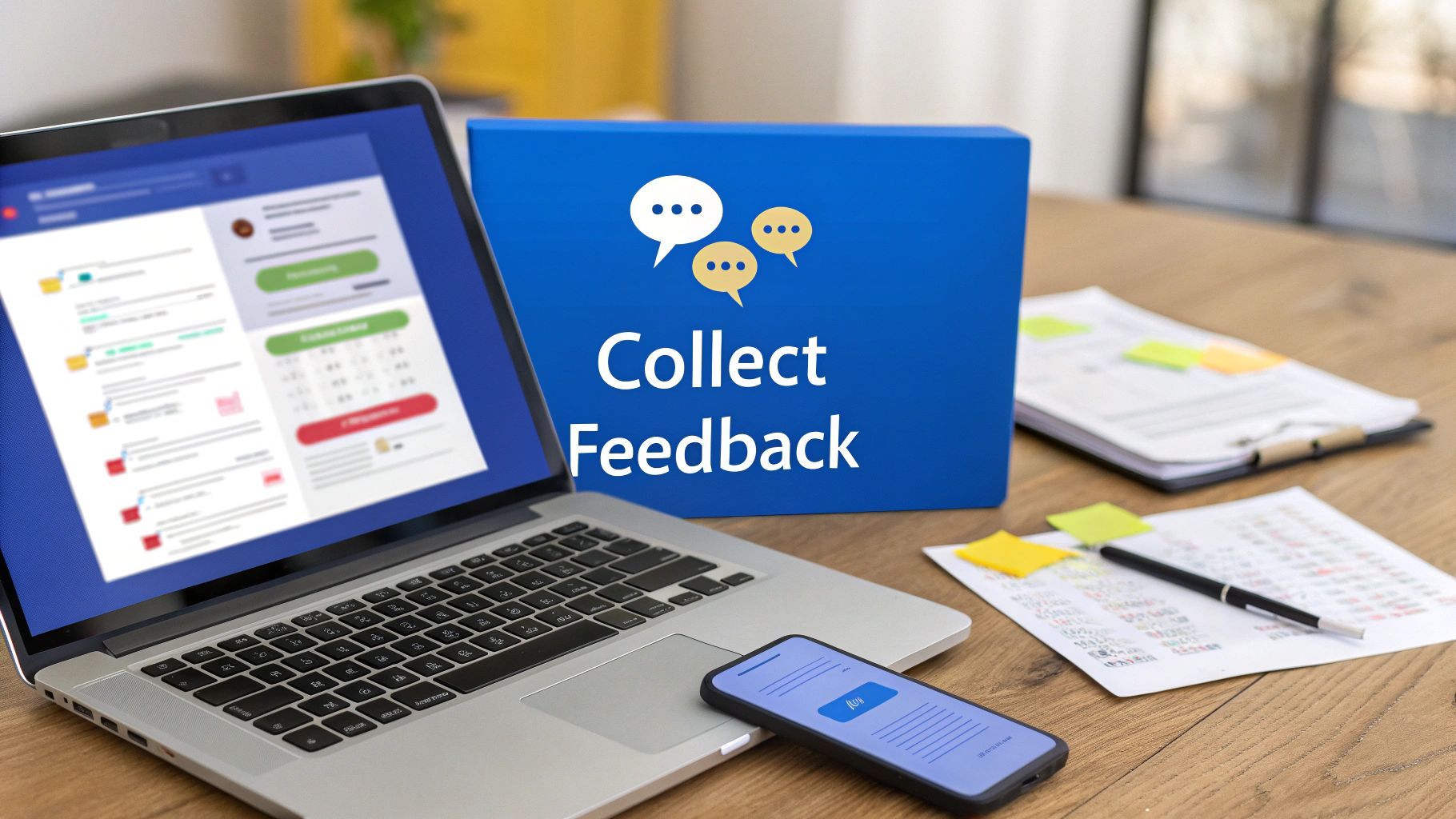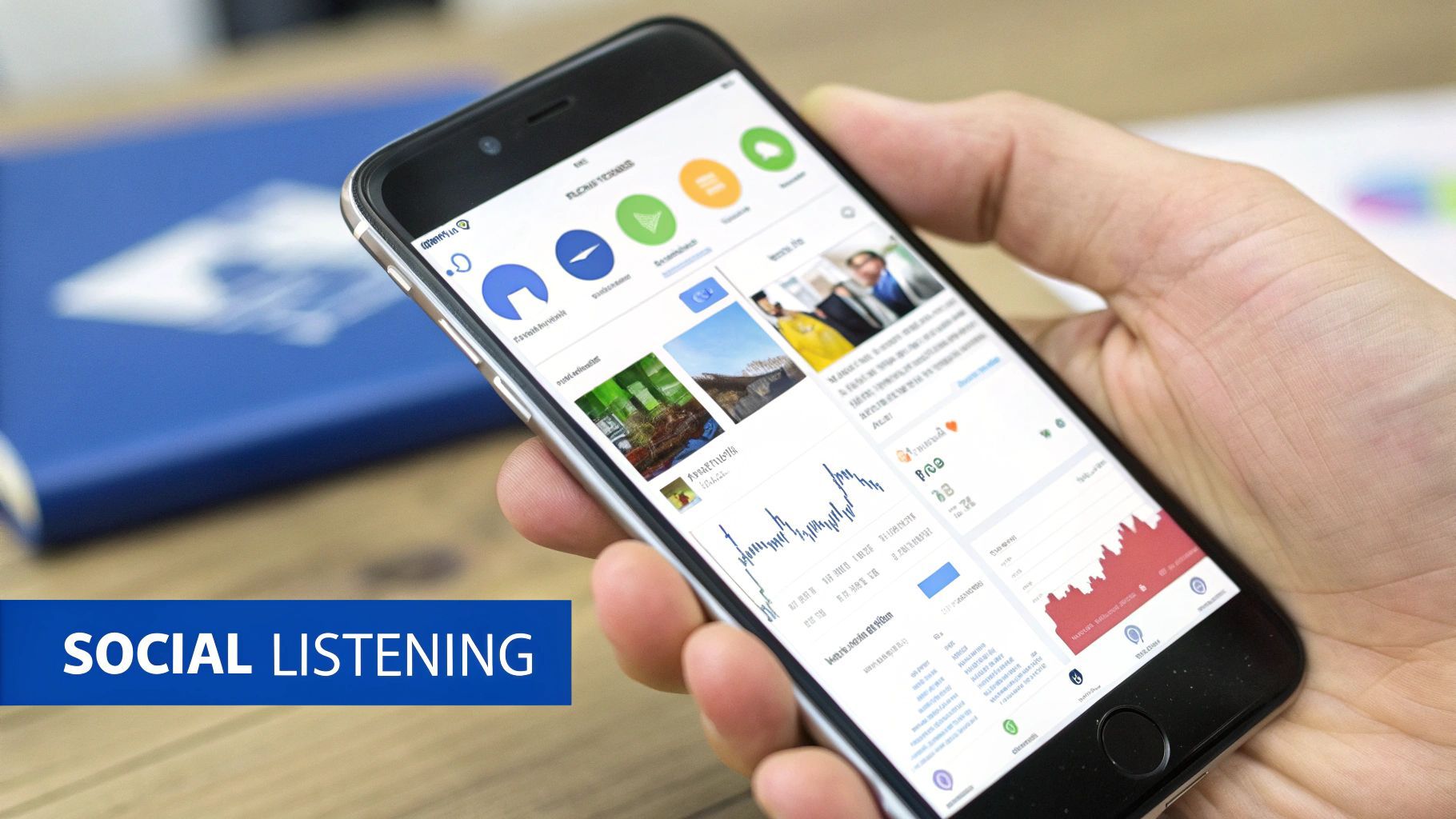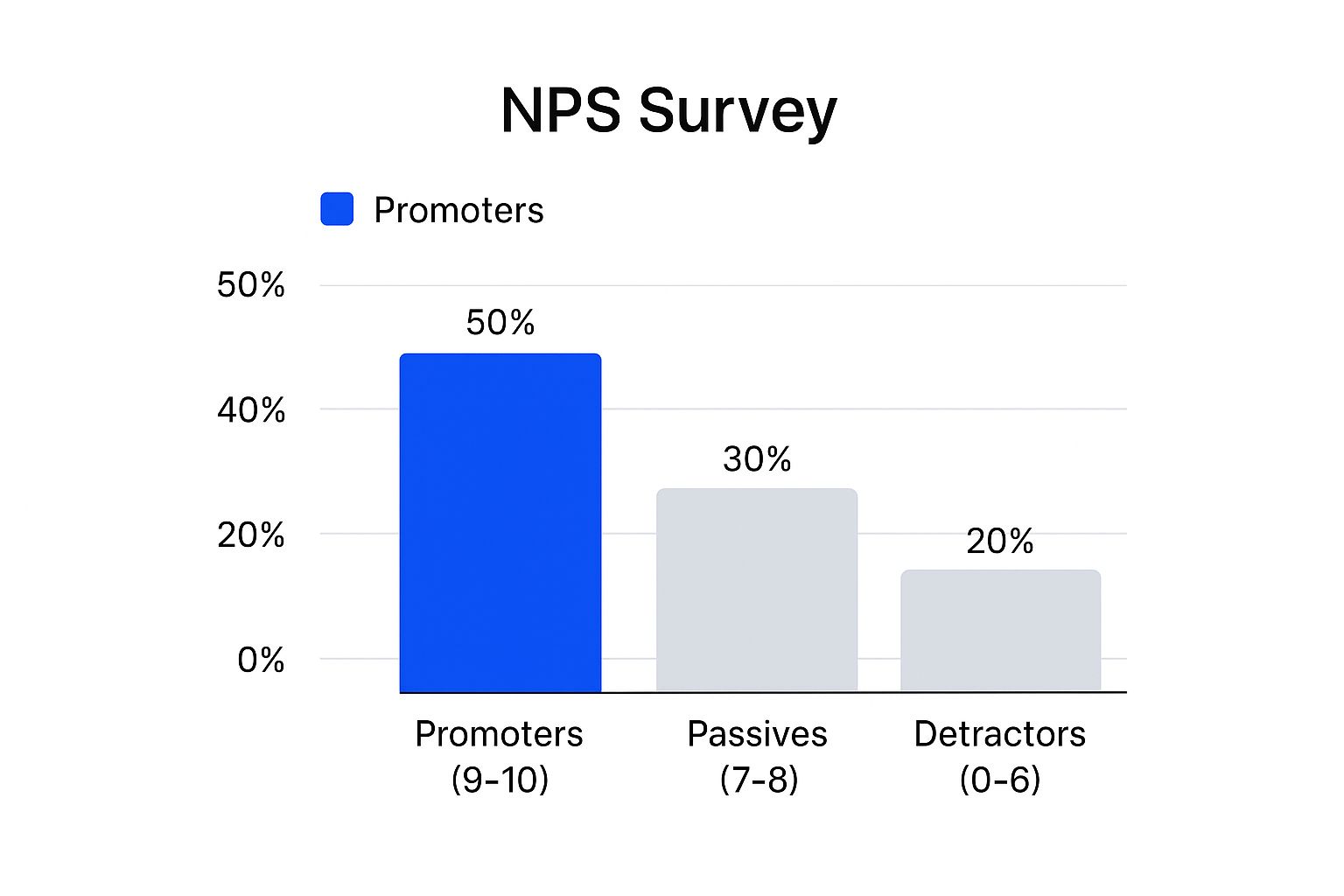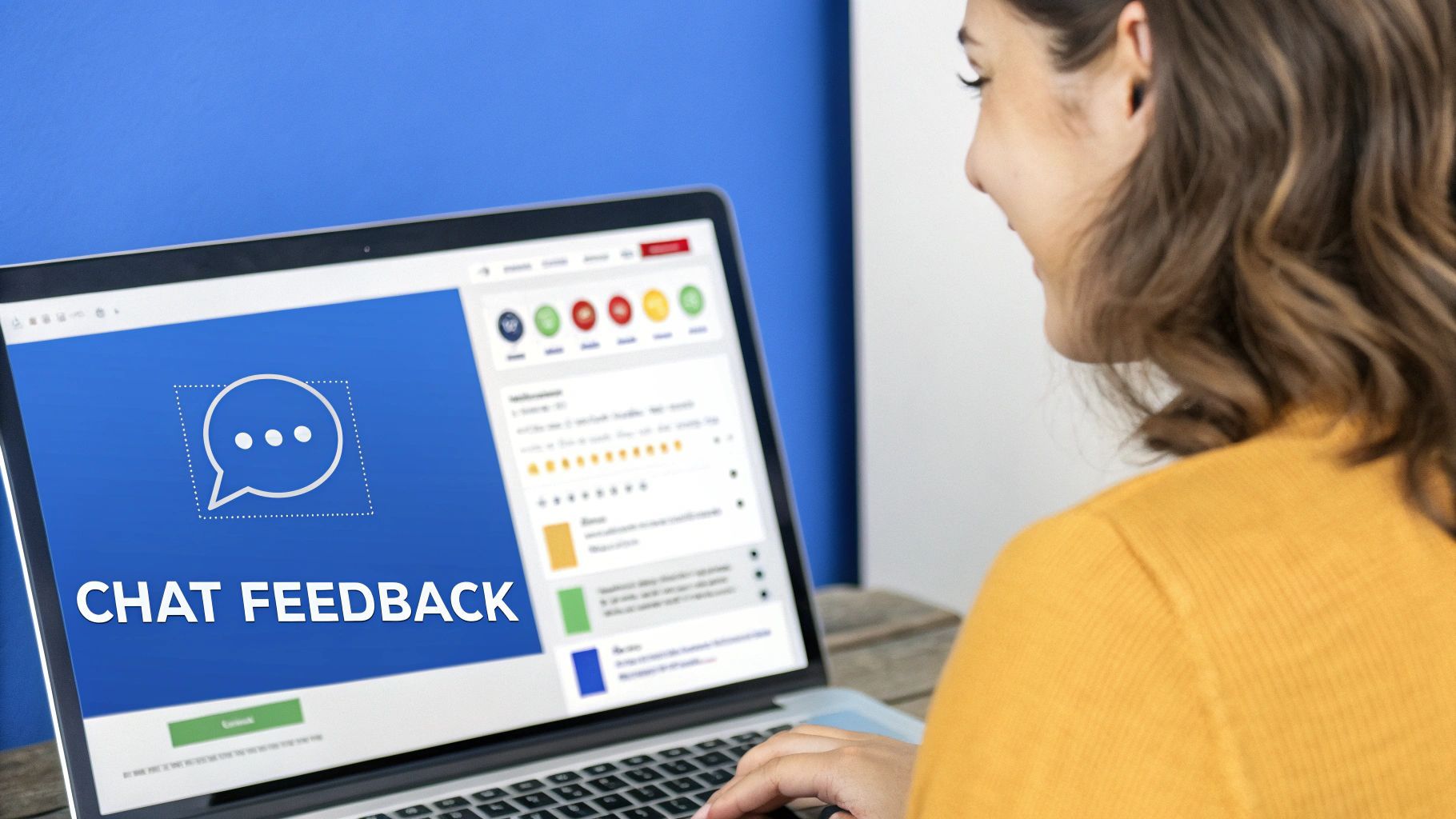
10 Proven Ways to Collect Customer Feedback in 2025
Discuss with AI
Get instant insights and ask questions about this topic with AI assistants.
💡 Pro tip: All options include context about this blog post. Feel free to modify the prompt to ask more specific questions!
In today's competitive market, understanding your customers is the bedrock of sustainable growth. The most successful brands are those that actively listen, adapt, and innovate based on direct user insights. This isn't just about fixing problems; it's about proactively identifying opportunities for improvement, from product development to the customer journey. When you truly grasp your customers' needs, motivations, and pain points, you can build stronger relationships and create experiences that foster loyalty.
This guide moves beyond generic advice to provide a comprehensive roadmap of powerful ways to collect customer feedback. We will explore a curated list of ten proven methods, each packed with actionable strategies, real-world examples, and specific tool recommendations. Ultimately, collecting customer feedback is a crucial component of a broader strategy for effectively managing customer engagement.
Whether you're a startup seeking product-market fit or an established enterprise aiming to reduce churn, mastering these methods will empower you to make data-driven decisions. You'll learn how to implement everything from online surveys and in-depth interviews to modern techniques like social media monitoring and website heatmaps. This ensures you capture every valuable insight needed to drive your business forward and stay ahead of the curve.
Online surveys are a foundational method for systematically gathering structured customer feedback. Deployed via email, website pop-ups, or social media, these digital questionnaires are invaluable for collecting quantitative data on customer experiences, product satisfaction, and demographic information. When designed effectively, surveys provide a scalable and cost-efficient way to measure sentiment across a broad audience. The key to success lies in creating engaging, concise, and targeted surveys that respect the customer's time while delivering deep, analyzable insights.
To make this one of the most effective ways to collect customer feedback, focus on precision and timing. A post-purchase survey sent 24 hours after delivery can capture immediate satisfaction, while an annual survey can track long-term loyalty. Use a mix of question types, including Net Promoter Score (NPS), multiple-choice, and Likert scales, to gather diverse data.
To maximize completion rates, keep surveys short (5-10 questions is ideal) and ensure they are mobile-responsive. For instance, an e-commerce brand could trigger a one-question pop-up survey asking, "How easy was it to find what you were looking for today?" on the checkout confirmation page. A strong foundation in designing effective online forms is crucial for building surveys that are intuitive and yield high-quality data.
- SurveyMonkey: A versatile platform with robust analytics and templates.
- Typeform: Known for its conversational and engaging user interface.
- Google Forms: A free and straightforward option for simple surveys.
Social media monitoring is a powerful, proactive method for tapping into the authentic, unfiltered voice of the customer. It involves tracking brand mentions, relevant keywords, and competitor conversations across platforms like Twitter, Instagram, and Reddit. Unlike solicited feedback, this approach captures spontaneous opinions and raw sentiment, offering a real-time pulse on public perception. By listening to these public conversations, brands can identify emerging issues, celebrate positive experiences, and gather product ideas directly from their audience.

To make this one of the most effective ways to collect customer feedback, set up alerts for your brand name, common misspellings, and key product names. Promptly and professionally engage with both positive and negative comments to show that you are listening. For example, Wendy's has built a strong brand personality through its active and witty Twitter engagement, while Tesla often monitors Reddit forums to understand deep-seated customer concerns and feature requests.
Create branded hashtags for campaigns or events to centralize feedback and make it easier to track. Also, monitor your competitors' mentions to uncover their weaknesses and identify opportunities in the market. Utilizing powerful social media automation tools can streamline this process, ensuring you capture comprehensive insights without manual overload.
- Sprout Social: Offers comprehensive social listening, publishing, and analytics in one platform.
- Hootsuite: A popular tool for monitoring multiple social streams and scheduling posts.
- Brandwatch: A robust consumer intelligence platform for in-depth sentiment analysis.
Customer interviews are one-on-one conversations that provide a direct line to your customer's thoughts, feelings, and motivations. Unlike structured surveys, these dialogues offer rich, qualitative data, uncovering the "why" behind customer behavior. This method is exceptionally powerful for exploring complex user experiences, validating new product ideas, and understanding deep-seated pain points. Pioneered by methodologies like Steve Blank's Customer Development, interviews allow you to build empathy and gather stories that quantitative data alone cannot capture, making this one of the most personal ways to collect customer feedback.
To get the most from this approach, preparation and technique are crucial. Plan a semi-structured interview with open-ended questions that encourage detailed responses. For instance, instead of asking, "Do you like our new feature?" ask, "Can you walk me through the last time you used our new feature?" This prompts a narrative. Creating a comfortable, non-judgmental environment is key to honest feedback.
Remember to ask for permission to record the session for easier analysis. Employ techniques like the "5 Whys" to dig deeper into a customer's initial response and uncover root causes. Offering a small incentive, like a gift card or product discount, shows you value their time and can significantly increase participation rates for these in-depth discussions.
- Zoom: Ideal for remote video interviews, with reliable recording features.
- Otter.ai: Uses AI to transcribe audio recordings, simplifying analysis.
- Calendly: Automates the scheduling process, making it easy for customers to book a time.
The Net Promoter Score (NPS) is a powerful, yet simple, customer loyalty metric used to gauge a customer's willingness to recommend your company, product, or service. It's built around a single, pivotal question: "On a scale of 0-10, how likely are you to recommend [Company/Product] to a friend or colleague?" Based on their response, customers are segmented into three categories: Promoters (score 9-10), Passives (score 7-8), and Detractors (score 0-6). The final NPS score, ranging from -100 to +100, is calculated by subtracting the percentage of Detractors from the percentage of Promoters. This makes NPS one of the most direct ways to collect customer feedback on overall loyalty.
To get the most from your NPS program, send surveys at key moments in the customer journey, such as after onboarding or following a support interaction. Always include an open-ended follow-up question like, "What is the primary reason for your score?" to uncover the "why" behind the number. This qualitative context is crucial.
Instead of obsessing over a single score, track your NPS trend over time. Segmenting results by customer demographics, purchase history, or geography can reveal deeper insights. For example, you might find that while your overall score is stable, loyalty is declining among a key customer segment. Companies like Apple and Tesla have famously used NPS to maintain industry-leading customer loyalty by acting on this feedback.
The bar chart below visualizes a typical distribution of responses from an NPS survey, breaking down the customer base into Detractors, Passives, and Promoters.

This visual breakdown immediately highlights that while Promoters form the largest group, a significant portion of customers are Detractors, signaling a clear area for improvement.
- Delighted: A specialized NPS platform known for its simplicity and powerful integrations.
- Satmetrix: Co-creator of the NPS methodology, offering comprehensive feedback solutions.
- AskNicely: A real-time customer feedback platform focused on driving action from NPS.
Focus groups offer a powerful way to collect customer feedback by gathering deep qualitative insights through moderated discussion. These sessions, typically involving 6-12 participants from a target demographic, allow businesses to explore nuanced attitudes, perceptions, and emotional responses to a product, service, or marketing concept. Unlike one-on-one interviews, the group dynamic can spark new ideas and reveal social influences on consumer behavior. This method is invaluable for understanding the "why" behind customer actions, providing rich, context-driven feedback that quantitative data alone cannot capture.
Effective implementation hinges on meticulous planning and skilled moderation. Start by recruiting a diverse yet representative group of participants that mirrors your target customer profile. The key is to create a comfortable, neutral environment where attendees feel open to sharing honest opinions. Prepare a structured discussion guide with open-ended questions but allow the moderator flexibility to probe interesting points that arise organically. For instance, a software company could use a focus group to observe how users collaborate on a new feature, revealing usability issues and collaborative workflows that surveys would miss.
- UserInterviews.com: A platform for recruiting and managing participants for user research and focus groups.
- Respondent.io: Connects researchers with high-quality business professionals and general consumers for studies.
- FocusVision (now Forsta): Provides comprehensive software and services for conducting both in-person and online focus groups.
Customer review platforms are digital town squares where customers publicly share their experiences with a product, service, or business. These third-party sites, like Yelp, Google My Business, or Trustpilot, build trust through transparent, user-generated content. Unlike direct feedback methods, reviews provide powerful social proof that influences new buyers and offers raw, unfiltered insights into what your business is doing right and where it needs to improve. Monitoring and engaging with these platforms is one of the most critical ways to collect customer feedback in the modern marketplace, as they directly impact brand reputation and discovery.
The key is proactive engagement and strategic integration. Actively encourage satisfied customers to leave reviews by sending automated follow-up emails a week after purchase, giving them enough time to have formed a solid opinion. It is crucial to respond to all reviews, both positive and negative. A professional, empathetic response to a negative review can turn a dissatisfied customer into a loyal advocate and shows potential buyers that you value feedback and are committed to service excellence.
For instance, a local restaurant could include a QR code on its receipts linking directly to its Yelp or Google review page. An e-commerce brand can use review insights to create a "Top Rated" product category on its website, leveraging positive feedback to guide new shoppers. Regularly analyzing review themes can highlight recurring issues with shipping, product quality, or customer service that need immediate attention.
- Trustpilot: A leading platform for collecting and showcasing company and product reviews.
- Yelp for Business: Essential for local businesses to manage their reputation and connect with customers.
- Google My Business: Critical for local SEO and managing reviews that appear directly in Google search and Maps.
Live chat and chatbots represent powerful, in-the-moment channels for gathering customer feedback directly within your digital environment. These tools provide immediate support and simultaneously serve as one of the most effective ways to collect customer feedback by capturing sentiment, satisfaction ratings, and qualitative comments during or right after an interaction. Whether it's a human agent solving a complex problem or an AI chatbot handling a routine query, the conversational interface creates a natural opportunity to ask for opinions when the experience is freshest in the customer's mind.

To maximize feedback collection, integrate simple, non-intrusive questions into the chat flow. For example, after resolving an issue, a chatbot can automatically ask, "On a scale of 1-5, how satisfied are you with this resolution?" This immediate query captures raw, unfiltered sentiment. Train your chatbots with a comprehensive knowledge base to answer common questions accurately, and program them to seamlessly escalate complex issues to a human agent to prevent frustration. Analyzing chat transcripts is also crucial for identifying recurring pain points and opportunities for service improvement.
For an even more proactive approach, trigger chat invitations based on user behavior, such as a customer lingering on the pricing page for several minutes. A well-timed pop-up can both offer assistance and gather valuable pre-purchase feedback. By using these real-time tools, you create a continuous feedback loop that is woven directly into the customer journey. You can explore how to automate customer support on spurnow.com to streamline this process further.
- Intercom: Excellent for targeted, behavior-driven messaging and integrating support with marketing.
- Zendesk Chat: A robust solution that integrates seamlessly with a broader customer service suite.
- Drift: Specializes in "conversational marketing" to engage and qualify leads while collecting data.
Email feedback campaigns are a powerful and direct method for gathering in-depth customer insights at specific lifecycle stages. By sending targeted emails post-interaction, you can request feedback on recent purchases, service experiences, or overall satisfaction. This approach allows for highly personalized and timely communication, making customers feel valued and more inclined to share their thoughts. Unlike passive methods, email campaigns proactively engage your audience, making them one of the most reliable ways to collect customer feedback for detailed analysis and action.
Timing and relevance are paramount for successful email feedback campaigns. An email sent immediately after a support ticket is resolved can capture sentiment about the service, while a request sent a week after product delivery can gather insights on product usage. Craft clear and compelling subject lines like "How was your recent purchase?" or "Share your thoughts and get 10% off" to boost open rates.
To maximize responses, keep the email concise with a single, clear call-to-action. For example, Zappos often sends simple post-delivery emails asking customers to rate their product and delivery experience. Segmenting your email lists based on purchase history or engagement level allows you to send hyper-relevant requests, significantly improving the quality and quantity of the feedback you receive. A well-executed email strategy is a cornerstone of any modern customer communication platform.
- Mailchimp: Excellent for segmenting audiences and automating trigger-based feedback emails.
- Constant Contact: Offers strong email deliverability and easy-to-use templates for feedback requests.
- SendGrid: A robust platform ideal for developers and businesses needing scalable email delivery for transactional and marketing feedback.
Website analytics and heatmaps offer powerful, indirect ways to collect customer feedback by observing what users do, not just what they say. These digital tracking tools analyze user behavior on websites and applications through data visualization, click tracking, scroll patterns, and user journey mapping. This method reveals unspoken customer preferences and pain points, providing invaluable insights into how people truly interact with your digital properties. For instance, Amazon famously optimizes its checkout funnel by analyzing where users drop off, while Netflix uses viewing patterns to perfect its content recommendations.
To turn behavioral data into actionable feedback, focus on key conversion pages like product listings, pricing pages, and checkout flows. Combine quantitative data from analytics with qualitative feedback from other sources to understand the "why" behind the "what." For example, if a heatmap shows users aren't clicking a key call-to-action button, you can follow up with a targeted pop-up survey on that page.
When analyzing website analytics, especially with a tool like Google Analytics 4, it's crucial to ensure a solid GA4 foundation to gather accurate behavioral clues. Set up goal tracking for important user actions, like form submissions or video plays, to measure what matters most. Regularly review these insights and, most importantly, act on them to improve the user experience while ensuring full privacy compliance.
- Google Analytics: The industry standard for tracking website traffic and user interactions.
- Hotjar: An all-in-one platform offering heatmaps, session recordings, and on-site feedback tools.
- Crazy Egg: Specializes in visual reports like heatmaps, scroll maps, and confetti reports.
A Customer Advisory Board (CAB) is a more formal, high-touch method among the ways to collect customer feedback, bringing together a select group of key customers to act as strategic advisors. These curated groups meet regularly with company leadership to provide in-depth insights on product roadmaps, market trends, and overall business strategy. Unlike other feedback channels, a CAB creates a collaborative partnership, allowing you to validate major decisions with your most valuable clients before they go to market. This approach is particularly powerful for B2B companies or brands with high-value customer segments, such as Salesforce's Customer Success Advisory Board.
Success depends on creating genuine value for board members. Start by selecting a diverse mix of customers who represent different segments, industries, and use cases. Develop a clear charter that outlines the board’s purpose, meeting cadence, and the commitment required.
Structure meetings with specific objectives and a formal agenda, ensuring discussions are strategic rather than tactical support sessions. To demonstrate the value of their input, consistently follow up on action items and communicate how their feedback influenced company direction. Offering exclusive benefits, like early access to new features or direct lines to executives, helps incentivize participation and shows appreciation for their commitment.
- Higher Logic: A community platform that can facilitate ongoing communication and document sharing for board members.
- Boardable: Software designed for board management, useful for scheduling, sharing agendas, and tracking minutes.
- Zoom or Microsoft Teams: Essential for hosting virtual CAB meetings and fostering interactive dialogue.
Feedback Method Implementation Complexity 🔄 Resource Requirements 🔄 Expected Outcomes 📊 Ideal Use Cases 💡 Key Advantages ⭐ Online Surveys Low - automated distribution Low - digital tools suffice Quantitative data with moderate depth Large audience feedback, quick satisfaction tracking Cost-effective, scalable, real-time analytics Social Media Monitoring Medium - requires tools & analysis Medium - software & analyst time Real-time, authentic sentiment insights Brand perception, trend spotting, competitor analysis Captures unsolicited opinions, immediate response Customer Interviews High - scheduling & conducting High - skilled interviewers Deep qualitative insights In-depth understanding of needs & motivations Detailed, contextual data, stronger relationships Net Promoter Score (NPS) Low - simple scoring & surveys Low - requires survey tool Customer loyalty score & segmentation Tracking customer loyalty and advocacy trends Easy to understand, industry benchmarked Focus Groups High - facilitation & recruitment High - moderator, logistics Rich qualitative data, group dynamics Concept testing, consumer attitudes & reactions Interactive idea generation, multi-perspective Customer Review Platforms Medium - platform management Medium - monitoring & responses Authentic user feedback, influence on buying Product/service reputation, user-generated content 24/7 availability, SEO benefits Live Chat & Chatbots Medium - chatbot setup & monitoring Medium - maintenance & training Immediate, contextual feedback Real-time support & feedback during interactions High engagement, quick issue resolution Email Feedback Campaigns Low - automated mailing systems Low - email platform & content Targeted feedback with measurable response rates Post-purchase, customer journey touchpoints Personalized, scalable, trackable open rates Website Analytics & Heatmaps Medium - technical integration Medium - analytics expertise Unbiased behavioral data, usability insights Digital experience optimization Large sample size, continuous unbiased data Customer Advisory Boards High - coordination & relationship High - executive & customer time Strategic insights & long-term feedback Strategic product planning, high-value customers Deep strategic insights, advocacy, early validation
You now have a comprehensive arsenal of ten powerful ways to collect customer feedback, from the broad strokes of online surveys and NPS scores to the nuanced details uncovered in customer interviews and focus groups. We've explored how to leverage social media monitoring, tap into review platforms, and utilize the real-time insights from live chat and website heatmaps. Each method offers a unique lens through which to view your customer's experience.
However, the true power isn't found in deploying any single one of these tactics in isolation. The most successful brands understand that collecting feedback isn't a one-time project; it's the engine of a continuous improvement cycle. The goal is to build a robust, interconnected system where insights flow seamlessly from your customers into your strategic decision-making process.
The real magic happens when you start layering these methods. Think of it as building a complete picture of your customer journey.
- Quantitative + Qualitative: Use quantitative data like NPS scores or website analytics to identify what is happening and where the friction points are. Then, deploy qualitative methods like customer interviews or social media listening to uncover the critical why behind those numbers. A drop-off in your checkout funnel (identified by analytics) becomes truly actionable when you hear customers explain their confusion in an interview.
- Proactive + Reactive: Balance proactive methods like email feedback campaigns with reactive ones like monitoring customer review platforms. This ensures you are not only guiding the conversation but also capturing the unsolicited, candid opinions that often hold the most valuable truths about your brand and products.
Gathering data is passive; creating change is active. Once the feedback is collected, the real work begins. Your next steps should be systematic and clear.
- Centralize Your Data: Funnel all feedback, regardless of the source, into a single, accessible repository or dashboard. This "single source of truth" prevents insights from getting lost in siloed departments and allows your team to see overarching trends.
- Prioritize and Triage: Not all feedback is created equal. Develop a framework for prioritizing issues based on factors like frequency, impact on revenue, alignment with business goals, and the effort required to implement a fix.
- Close the Loop: This is the most crucial, and often most overlooked, step. Actively communicate back to your customers. Let them know you've heard their feedback and, more importantly, tell them what you're doing about it. This simple act transforms customers from passive buyers into a loyal community that feels valued and invested in your success.
Mastering these ways to collect customer feedback and, more importantly, acting on them, is what separates market leaders from the rest. It’s how you turn a simple transaction into a lasting relationship, a good product into a great one, and a static business into a dynamic, customer-centric flywheel that constantly gains momentum. The journey begins with listening, but it culminates in meaningful action and sustainable growth.
Ready to centralize your feedback and turn customer insights into your biggest growth driver? Spur consolidates feedback from all your channels into one powerful, easy-to-use platform, helping you analyze trends and prioritize action. Stop juggling spreadsheets and start building a better business at Spur.
